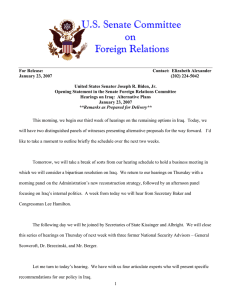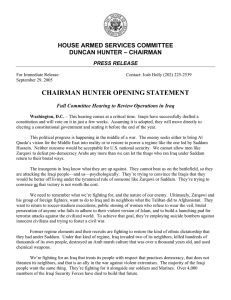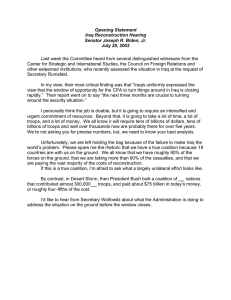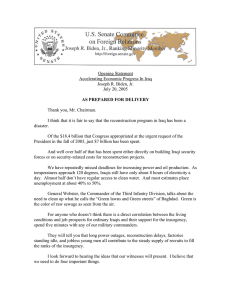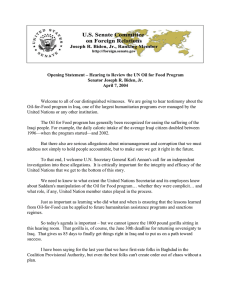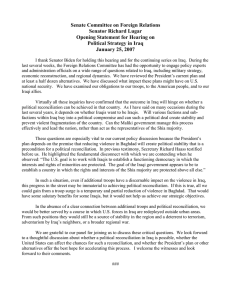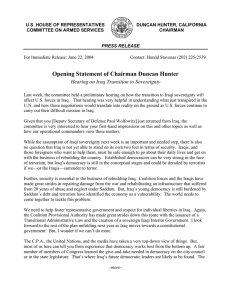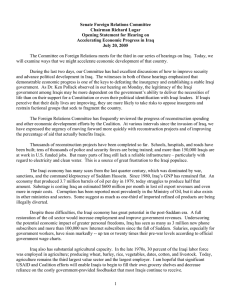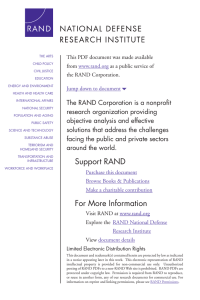6 om as a public service of the RAND Corporation.
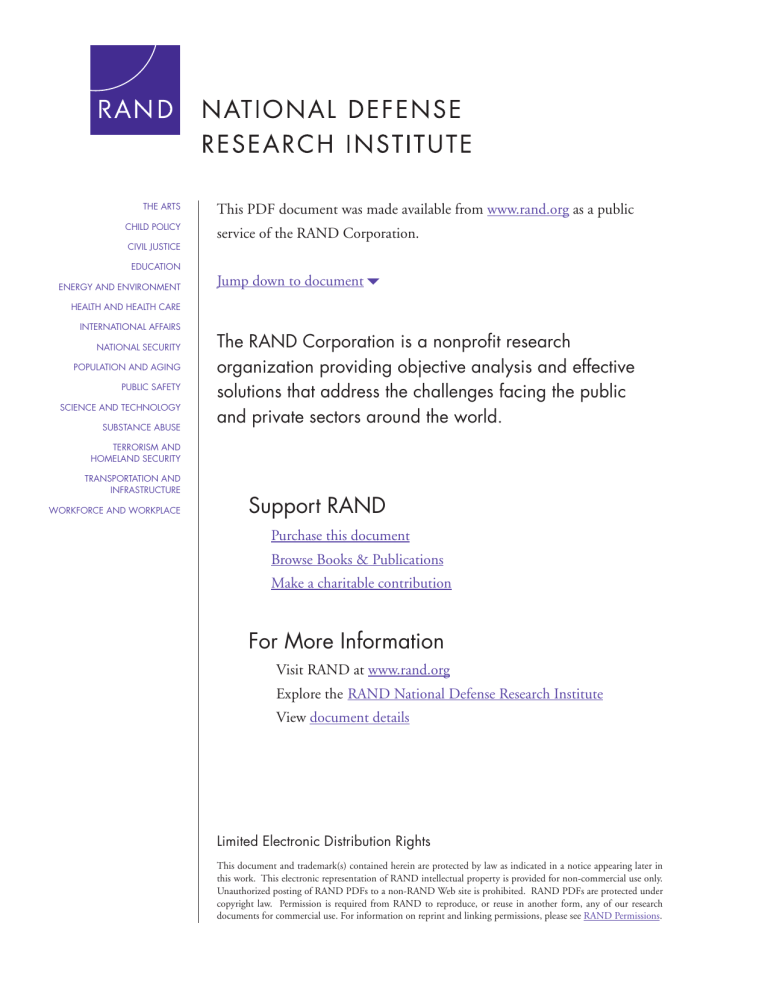
THE ARTS
CHILD POLICY
CIVIL JUSTICE
EDUCATION
ENERGY AND ENVIRONMENT
HEALTH AND HEALTH CARE
INTERNATIONAL AFFAIRS
NATIONAL SECURITY
POPULATION AND AGING
PUBLIC SAFETY
SCIENCE AND TECHNOLOGY
SUBSTANCE ABUSE
TERRORISM AND
HOMELAND SECURITY
TRANSPORTATION AND
INFRASTRUCTURE
WORKFORCE AND WORKPLACE
This PDF document was made available from www.rand.org
as a public service of the RAND Corporation.
The RAND Corporation is a nonprofit research organization providing objective analysis and effective solutions that address the challenges facing the public and private sectors around the world.
Support RAND
Purchase this document
Browse Books & Publications
Make a charitable contribution
For More Information
Visit RAND at www.rand.org
Explore the RAND National Defense Research Institute
View document details
Limited Electronic Distribution Rights
This document and trademark(s) contained herein are protected by law as indicated in a notice appearing later in this work. This electronic representation of RAND intellectual property is provided for non-commercial use only.
Unauthorized posting of RAND PDFs to a non-RAND Web site is prohibited. RAND PDFs are protected under copyright law. Permission is required from RAND to reproduce, or reuse in another form, any of our research documents for commercial use. For information on reprint and linking permissions, please see RAND Permissions .
This product is part of the RAND Corporation occasional paper series. RAND occasional papers may include an informed perspective on a timely policy issue, a discussion of new research methodologies, essays, a paper presented at a conference, a conference summary, or a summary of work in progress. All RAND occasional papers undergo rigorous peer review to ensure that they meet high standards for research quality and objectivity.
Erratum
To: Recipients of OP-272-OSD, The Impact of U.S. Military Drawdown in Iraq on Displaced and Other Vulnerable Populations: Analysis and Recommendations
From: RAND Corporation Publications Department
Date: February 2010
Re: Corrected page (p. 5)
In footnote 4, on page 5, the text originally read,
In addition, the Department of Defense has the capacity to rapidly evacuate limited numbers of senior and/or prominent individuals affiliated with department staff and at specific, demonstrated near-term risk through the Significant Public Benefit Parole program.
It should read,
In addition, the Department of Defense has the capacity to rapidly evacuate limited numbers of people affiliated with department staff and at specific, demonstrated near-term risk through the Significant Public Benefit Parole program. It has been used both to evacuate
Iraqis in danger because of their ties to the United States and those facing life-threatening medical emergencies that require treatment outside of Iraq.
1
Vulnerable Populations 5
States to protect and help the people who were willing to help Americans would be rightly seen as a particularly egregious moral violation. In the Middle East and around the world, this would feed into and would be used to build anti-U.S. sentiment. That, in turn, would hamper
U.S. efforts on a broad range of issues as the United States seeks to rebuild its global image and influence. Importantly, such a deleterious outcome would ultimately set a poor precedent for future U.S.-led military operations, making local citizens elsewhere less likely to help the
United States.
Successful attacks against the truly vulnerable may also be a starting point for broader violence in Iraq if group tensions escalate into cycles of provocation and reprisal. A demonstrated failure of the Iraqi Security Forces to keep these people safe would also undermine faith in Iraq’s government more broadly, feeding violence and instability and damaging security not just in Iraq, but the broader region.
The likelihood that there will be substantial violence against vulnerable people varies somewhat from group to group. Some level of violence against minorities, such as the Yazidis, and refugee groups, such as the Palestinians, who live within Iraqi communities, is fairly likely, as are some attacks against U.S. allies. Such violence is also more likely if the government of
Iraq does not place a priority on the protection of the vulnerable. High levels of violence are more likely if the overall security situation worsens.
Current Policy Responses
U.S.-Affiliated Iraqis
Congressional and public concern about the plight of U.S.-affiliated Iraqis, who already have been targeted by a variety of groups, has resulted in a number of important policy steps in the past year, particularly those geared toward easing immigration to the United States for those who seek it. The Special Immigrant Visa program and the U.S. Refugee Resettlement Program are the two currently extant mechanisms by which Iraqis with affiliations to the United States can come to America.
4
The Special Immigrant Visa (SIV) program as it applies to Iraq adapts a State Department program (of the same name) that rewards long-term local employees of embassies abroad. The adaptation of this program to Iraq (and Afghanistan) was driven by a need and desire to provide a resettlement option for local staff who might be at risk. As of 2008, eligibility is open to any Iraqi who has worked for the U.S. government or military (including military contractors) for at least a year and who is or was threatened as a result. Unlike the SIV program as it applies in other countries, the SIV program for Iraq and Afghanistan provides resettlement assistance in the United States similar to that provided to refugees to the United States. SIV applicants must prove their service with documentation and letters of recommendation from present or former U.S. government personnel. As of fiscal year (FY) 2008, the program is authorized to accept 5,000 Iraqis per year and their immediate family members (spouses and unmarried
4 In addition, the Department of Defense has the capacity to rapidly evacuate limited numbers of people affiliated with department staff and at specific, demonstrated near-term risk through the Significant Public Benefit Parole program. It has been used both to evacuate Iraqis in danger because of their ties to the United States and those facing life-threatening medical emergencies that require treatment outside of Iraq.
6 The Impact of U.S. Military Drawdown in Iraq on Displaced and Other Vulnerable Populations children under age 21). Actual numbers have lagged, however, with fewer than 600 applicants admitted in FY2008.
The U.S. Refugee Resettlement Program is the main way that refugees from around the world come to the United States. Prospective refugees are required to prove a well-founded fear of persecution. As of 2008, the U.S. government has deemed that Iraqis who are or were employed by the U.S. government, U.S.-headquartered media or nongovernmental organizations (NGOs), and entities closely associated with the U.S. mission that received U.S. government funding are qualified. Also qualified are those who are members of persecuted religious groups and those with close family in the United States. Other people in need may also be qualified. Everyone who is eligible for the SIV program is eligible for the refugee program, but the reverse is not true. Specifically, employees of nongovernmental entities and employees of contractors to any U.S. government agency other than the Defense Department are eligible only for the refugee program.
5 The refugee program also allows some applicants, on a case-bycase basis, to bring a broader set of family members with them, including, for example, parents and married children.
Iraqis with ties to the United States can apply to either or both of these programs in
Jordan, Syria, and other countries of first refuge after they have fled Iraq. As of summer 2008, they can also apply at the U.S. Embassy in Baghdad.
6 However, processing, including investigations, interviews, and so forth, includes multiple U.S. government agencies and contractors and takes many months to complete. A new applicant for the refugee program through the U.S. Embassy might expect to wait two years. The wait for the SIV program is shorter, in some cases as short as nine weeks, because of recent increases in staffing and the use of electronic processing via the Internet. All processing, though, is delayed by various bottlenecks.
For example, security screening that is supposed to take 30 days per case generally takes 150 days. Candidates, moreover, must also wait for Department of Homeland Security (DHS) interviews, which occur when DHS personnel visit the region.
Plans for evacuation: One of the greatest dangers for U.S.-affiliated Iraqis is that in the event of an emergency, the threat will increase, but U.S. capacity to assist will not. In line with this, 2008 legislation has called on the U.S. government to develop a database of Iraqis eligible for resettlement to the United States. According to most of those involved, the United States has access to the records needed for such a database. However, it has not yet been developed.
U.S. Embassy personnel note that this has not been a problem to date, as most Iraqis seeking resettlement are able to provide the necessary documentation, but it would be a problem if processes needed to be rapidly sped up.
Other Groups at Risk
The MEK: The MEK’s history of violent activity makes resettlement in the United States,
Europe, or elsewhere unlikely. The United States has sought and received assurances from the
Iraqi government that MEK members will receive humane treatment. The U.S. Embassy and
U.S. government continue to engage the Iraqi government on these issues. However, there is concern among staff of both the U.S. government and nongovernmental organizations that on contractors.
otherwise pose.
Vulnerable Populations 7 the Iraqi government may subsequently turn them over to Iran. Indeed, the Iraqi government indicated in late 2009 that it intends to forcibly evict MEK members from Camp Ashraf/New
Iraq (Londoño, 2009). Because of their history, MEK members fear violent reprisal if they return.
7 MEK leaders and advocates also assert that residents at the camp are in danger even if they stay in Iraq, citing a July 2009 security force action at the camp that resulted in the arrest of 36 camp residents and reportedly the deaths of nine (Cody, 2009).
Refugees from other states: UNHCR has sought resettlement for the Palestinians and other refugees living in Iraq. As a result, a few have found new homes in Chile, Sweden, Norway,
Iceland, and Switzerland. The United States has agreed to take 1,350 displaced by fighting
(Jordan, 2009). Many others, however, remain stranded in abysmal conditions. In late 2008, about 100 Sudanese refugees who had fled Baghdad due to attacks on their community and had lived in a desert camp for over two years were found homes in Romania. Such limited successes indicate that solutions are possible. They also underline the difficulties and long timelines of resettlement.
For the thousands of Palestinians in Baghdad, resettlement en masse is unlikely. The
United States is working with the Iraqi government to ensure that this Palestinian community receives new ID cards and to acquire assurances that their rights as residents of Iraq will be upheld. There remain concerns that such steps will be insufficient to ensure the long-term safety of this group.
Guest workers: As with the other groups at risk, the U.S. Embassy and government are aware of the relevant issues and concerns and discuss them with their Iraqi colleagues. Specifically, the U.S. government has sought to ensure that its own contractors do not violate U.S. laws and that all laborers they bring in are treated and compensated appropriately. DoD contractor KBR, for example, reportedly responded to an over-hiring problem by repatriating the unneeded employees with a few months’ pay. Little has been done, however, on broader issues of ensuring the security of contractor personnel, regardless of who hired them. When U.S. forces depart, much of the leverage the United States has to help address concerns related to any contractors other than those directly reporting to the U.S. government will depart with them.
the top leadership amnesty, suggesting that a full return of all MEK members might be possible. However, it is understandable that MEK members would not be willing to accept these indicators as sufficient evidence of safety.
